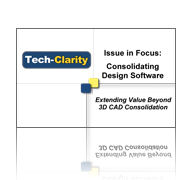Latest News
December 12, 2013
 |
When the light is off at night, all the electronic stuff on standby makes my office twinkle like a little city. Blue lights on the Windows PC and backup drive. Red lights on the two printers and one on each phone. Green lights on the Macs, a scanner, and the network node. That, of course, means that my office at night and your day-to-day workflow have something in common: Both hemorrhage money and we rarely think about it. Only you lose a lot more dough because you’re constantly wasting time and money healing translation problems, nursing along old hardware and software, and making work more difficult for upstream and downstream stakeholders. My excuse is sloth. Yours is that you’re working in a multi-CAD environment with multiple disconnected tools and multiple money pits bleeding you dry at every junction of your process.
“Consolidating Design Software, Extending Value Beyond 3D CAD Consolidation” is a 13-page white paper that makes the case for consolidating your design environment with an integrated design suite that is multi-CAD capable. Written by Jim Brown for Tech-Clarity, a research and consulting firm, the paper argues that an integrated design suite that helps keep design intent from conceptual design through the rest of the product lifecycle provides a flexible, cost-effective approach to taming your multi-CAD environments and data. The focal point, however, is less on just having a consolidated 3D solution. Rather, it is on the potential benefits to your entire product lifecycle from concept through manufacturing and documentation.
To his credit, Brown fully recognizes that most outfits can and will never fully consolidate their design systems because of business pressures ranging from customer demands to supply chain relationships. Still, what the paper does is make a compelling case that consolidation and standardization is a valuable, time- and money-saving goal that should be pursued from angles that you might not have considered.
Brown sets the table with what you know: Standardization on a direct modeling system that interoperates with detail design provides a design-wise common data set. A common CAD data model can practically eliminate non-productive procedures such as recreating data and fixing imperfect translations. It improves data sharing and data reuse as well as disposes of disconnected tools.
But it can also relieve haphazard communications from concept sketching through detail design to manufacturing, and it accommodates the different ways different departments work with the data. Your design intent is carried from start to finish. It results in higher productivity, greater agility, and faster response to rapidly changing markets. And it could provide direct financial, complexity, and time saving relief by eliminating multiple hardware and software systems.
The paper’s strength lies in two areas. The first, and its greatest strength, begins on page 8 under the subheading “The Expanded ROI Model.” Basically, this is an ROI (return on investment) template on steroids that can help you analyze and obtain a ballpark figure on the potential benefits of consolidating your 2D and 3D CAD solutions. By “steroids,” I mean that the kicker Brown offers you is a straightforward grid that prods you to enumerate the upstream and downstream costs of maintaining a non-consolidated multi-CAD environment: license fees, maintenance of discontinued hardware and software, training, help desk, and so forth. It has some example numbers plugged in—your mileage will vary—but they seem reasonable. The savings more than offsets the transition.
The second notable area of strength begins on page 12. “Recommendations” is a short, bulleted list that’s good for all and especially spot-on for the engineering manager for whom everything else in the paper has been an eye-opener. It’ll help you organize your thoughts and sketch out a plan for staunching the flow of wasted time, money, and productivity that might well be the description of your design environment.
Hit today’s Check it Out link and download “Consolidating Design Software, Extending Value Beyond 3D CAD Consolidation.” It’s a good read that should provoke a lot of introspection.
Thanks, Pal. – Lockwood
Anthony J. Lockwood
Editor at Large, Desktop Engineering
Download “Consolidating Design Software, Extending Value Beyond 3D CAD Consolidation”
Subscribe to our FREE magazine, FREE email newsletters or both!
Latest News
About the Author
Anthony J. Lockwood is Digital Engineering’s founding editor. He is now retired. Contact him via [email protected].
Follow DE





